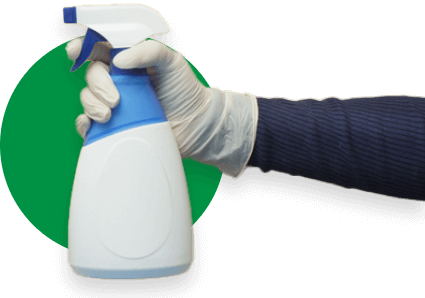Hospital patient room cleaning checklists ensure infection control and patient safety. These systematic procedures reduce healthcare-associated infections through proper disinfection protocols. Maintaining consistent hygiene standards protects both patients and healthcare workers effectively.
What Is a Hospital Patient Room Cleaning Checklist?
A hospital patient room cleaning checklist is a systematic protocol healthcare facilities use to maintain hygiene standards. This checklist includes specific tasks like surface disinfection, waste disposal, and floor care. Each item ensures comprehensive coverage of patient room cleaning procedures.
The checklist typically includes these core components:
- Visual Assessment: Cleaning staff identify obstacles, needed supplies, and damaged items requiring attention or replacement.
- Surface Disinfection: High-touch areas like bed rails, doorknobs, and light switches receive priority disinfection treatment.
- Waste Management: Safe removal and disposal of contaminated materials minimizes cross-contamination risks throughout the facility.
- Floor Care: Hospital-grade disinfectants eliminate pathogens from floors through systematic sweeping and mopping procedures.
These protocols create standardized cleaning approaches across all patient rooms.
Why Hospital Patient Room Cleaning Checklists Matter
Patient room hygiene directly impacts health outcomes in healthcare settings. Pathogens survive on multiple surfaces, including mattresses, bedframes, toilets, and floors. Research shows these contaminated surfaces contribute significantly to healthcare-associated infections.
Proper cleaning procedures reduce infection transmission between patients and staff. Studies indicate 80% of infections spread through hand contact with contaminated surfaces. Our medical facility cleaning services implement evidence-based protocols to minimize these risks.
Systematic checklists ensure no surface goes unnoticed during routine cleaning. This comprehensive approach protects vulnerable patient populations from preventable infections. Healthcare facilities maintaining strict hygiene standards demonstrate commitment to patient safety and regulatory compliance.

Framework of Hospital Patient Room Cleaning Procedures
Healthcare facilities follow structured approaches to maintain sterile environments consistently. The systematic framework ensures thorough coverage of all cleaning requirements. Staff members complete specific tasks in predetermined sequences to maximize effectiveness.
The cleaning process follows this systematic approach:
- Room Assessment: Staff evaluate the space for specific cleaning challenges, obstacles, and required supplies before starting.
- Systematic Movement: Cleaners work clockwise or left-to-right in multi-bed areas to ensure comprehensive surface coverage.
- Contamination Sequence: Less contaminated surfaces receive cleaning before more contaminated ones to minimize pathogen spread.
- Top-to-Bottom Method: This approach prevents recontamination of already cleaned surfaces during the cleaning process.
This framework creates predictable, repeatable cleaning outcomes across all patient rooms.
Professional cleaning teams complete these procedures efficiently while maintaining quality standards and understanding the importance of systematic approaches in health care environments.
Time Requirements for Hospital Patient Room Cleaning
Cleaning times vary based on room size and contamination levels. Standard hospital patient room cleaning procedures typically require 25 to 45 minutes per room. Complex situations like isolation rooms or post-discharge terminal cleaning demand additional time.
Several factors influence cleaning duration:
- Room Size: Larger patient rooms contain more surfaces requiring disinfection and longer cleaning times overall.
- Contamination Level: Rooms housing infectious patients require enhanced protocols that extend cleaning duration significantly.
- Equipment Quantity: Medical equipment increases the number of surfaces requiring specialized cleaning and sterilization procedures.
- Occupancy Status: Occupied rooms require careful navigation around patients, while vacant rooms allow unrestricted access.
Cleaning teams balance speed with thoroughness to maintain hygiene standards. Rushing through procedures compromises infection control effectiveness, prioritize quality over speed in all situations.
Key Industry Standards for Healthcare Facility Cleaning
Stringent regulations govern healthcare cleaning to protect patient safety consistently. Multiple organizations establish standards that facilities must follow. Compliance with these guidelines demonstrates commitment to infection prevention and patient welfare.
| Standard Area | Requirement | Implementation |
| Routine Cleaning | Daily disinfection of all surfaces | Scheduled during low-traffic periods |
| Deep Cleaning | Comprehensive terminal cleaning | After patient discharge or weekly |
| Disinfection Protocols | EPA-registered hospital-grade products | Applied per manufacturer guidelines |
| Staff Training | Continuous education on latest protocols | Quarterly certification updates |
| Isolation Rooms | Enhanced cleaning and waste protocols | Implemented during and after occupancy |
| Equipment Sterilization | Medical equipment cleaned after each use | Following device-specific guidelines |
These standards form the foundation of effective healthcare facility cleaning programs.
Hand hygiene remains critical since 80% of infections transmit through hand contact. Personal protective equipment usage during cleaning prevents staff exposure to pathogens. Proper PPE disposal after cleaning tasks reduces contamination risks throughout facilities.
Daily Hospital Patient Room Cleaning Checklist Components
Daily cleaning maintains baseline hygiene standards between deep cleaning sessions. These routine tasks prevent pathogen accumulation on frequently touched surfaces. Consistency in daily cleaning reduces overall infection transmission rates.
The comprehensive daily checklist includes:
- High-Touch Surface Disinfection: Bed rails, call buttons, doorknobs, light switches, and medical equipment receive priority attention.
- Bathroom Sanitization: Toilets, sinks, soap dispensers, and floors undergo thorough cleaning with hospital-grade disinfectants.
- Bedside Area Care: Nightstands, overbed tables, and chairs receive disinfection to eliminate pathogen accumulation.
- Floor Maintenance: Sweeping removes debris before mopping with EPA-registered disinfectants eliminates remaining pathogens.
- Waste Removal: Trash and biohazard containers receive proper emptying and liner replacement following facility protocols.
- Linen Management: Soiled linens undergo safe removal and replacement with fresh, sanitized bedding materials.
These tasks maintain continuous hygiene protection for patients throughout their stays.
Cleaning teams respect patient privacy while performing necessary cleaning duties, balance thoroughness with minimal patient disruption during occupied room cleaning.

Hospital Patient Room Cleaning Checklist Variations by Facility Type
Different healthcare facilities adapt cleaning checklists to their specific operational needs. Each facility type presents unique challenges requiring specialized approaches. Understanding these variations helps cleaning teams deliver appropriate service levels.
Standard patient rooms in general hospitals receive routine daily cleaning protocols. These rooms follow the comprehensive checklist covering all standard surfaces and equipment. Cleaning teams complete these rooms within the typical 25-45 minute timeframe.
Intensive Care Unit rooms require enhanced cleaning protocols beyond standard procedures. ICU cleaning includes strict infection control measures and meticulous equipment sterilization. Terminal cleaning after patient discharge receives particular attention in ICU settings. Proper ventilation protocols remove nearly all airborne pathogens per CDC guidelines.
Isolation rooms housing infectious patients demand the highest level of cleaning rigor. Enhanced disinfection protocols target specific pathogens identified in patient diagnoses. Waste disposal procedures follow strict containment protocols to prevent pathogen spread. Cleaning teams wear enhanced PPE during isolation room cleaning for personal protection.
Outpatient facilities maintain modified checklists reflecting shorter patient exposure times. These facilities focus on high-touch surfaces in exam rooms and waiting areas. Cleaning frequencies adjust based on daily patient volume and facility usage patterns.
Most Common Contaminated Surfaces in Patient Rooms
Specific surfaces harbor pathogens more frequently than others in patient environments. Research identifies consistent contamination patterns across healthcare facilities. Targeting these high-risk surfaces improves overall infection control effectiveness.
The most commonly contaminated surfaces include:
- Mattresses and Linens: Direct patient contact creates significant contamination requiring thorough cleaning between patients.
- Bedframes and Rails: Frequent touching by patients and staff transfers pathogens to these surfaces constantly.
- Bathroom Fixtures: Toilets, sinks, and soap dispensers accumulate diverse pathogens from regular use.
- Floor Surfaces: Pathogens settle on floors from air circulation and dropped items requiring systematic floor care.
Understanding contamination patterns helps cleaning teams prioritize their efforts effectively.
These surfaces receive enhanced attention during both routine and terminal cleaning procedures. Hospital patient room cleaning checklists specifically identify these areas for thorough disinfection.
Proper Cleaning Sequence and Methodology
Effective cleaning follows specific sequences to prevent cross-contamination during procedures. The systematic approach moves from least contaminated to most contaminated surfaces. This methodology protects already-cleaned areas from recontamination during the process.
The standard five-step cleaning procedure includes:
- Surface Preparation: Remove loose debris and dust from surfaces before applying any cleaning solutions.
- Washing: Apply soap and water to surfaces to remove visible dirt and organic matter.
- Rinsing: Thoroughly rinse away soap residue that could interfere with disinfectant effectiveness.
- Disinfection: Apply EPA-registered disinfectants following manufacturer contact time requirements to kill pathogens.
- Drying: Allow surfaces to air dry or use clean cloths to prevent bacterial growth.
This sequence ensures maximum disinfection effectiveness across all surface types.
The three major cleaning steps encompass cleaning with soap, disinfecting with chemicals, and sanitizing. Chlorine-based disinfectants containing 500-5000 ppm free chlorine effectively eliminate most pathogens. Mixing ratios require careful measurement: one part 5% chlorine bleach with 100 parts water. Never use chlorine disinfectants on urine spills due to hazardous chemical reactions.
Elevate Your Medical Facility’s Hygiene with Expert Hospital Patient Room Cleaning Checklist Implementation
Hospital patient room cleaning checklists provide essential frameworks for infection control and patient safety. Systematic procedures ensure comprehensive coverage of all contaminated surfaces and high-touch areas. Dallas Janitorial Services has extensive experience implementing evidence-based cleaning protocols in healthcare facilities. Contact us today to learn how our specialized medical cleaning services protect your patients.
Frequently Asked Questions About Hospital Patient Room Cleaning Checklists
How do they clean hospital rooms?
Hospital patient room cleaning procedures follow systematic approaches including surface disinfection and waste disposal. Staff dust surfaces, sanitize high-touch areas, change linens, and mop floors with hospital-grade disinfectants. The process ensures optimal hospital room maintenance and infection control throughout facilities.
How do you clean an ICU room?
ICU room cleaning starts with strict infection control measures and comprehensive surface disinfection. Terminal cleaning after patient discharge includes meticulous equipment sterilization and enhanced waste disposal. Proper ventilation removes nearly all airborne pathogens following CDC guidelines for infectious patient rooms.
What is routine cleaning in the hospital?
Routine cleaning refers to daily tasks maintaining consistent hygiene standards in healthcare facilities. This includes surface disinfection, floor cleaning, waste management, and high-touch area sanitization. These procedures prevent pathogen accumulation between more intensive deep cleaning sessions.
What are the five steps in a cleaning procedure?
The five cleaning procedure steps include preparing surfaces by removing debris and dust. Washing with soap and water removes visible dirt before rinsing eliminates soap residue. Disinfectants kill remaining germs before surfaces dry to prevent bacterial regrowth.
What are the three major steps in cleaning?
The three major cleaning steps encompass cleaning with soap to remove dirt. Disinfecting with chemicals kills germs on surfaces throughout the space. Sanitizing reduces and prevents germ spread using appropriate hospital-grade disinfectant products.







